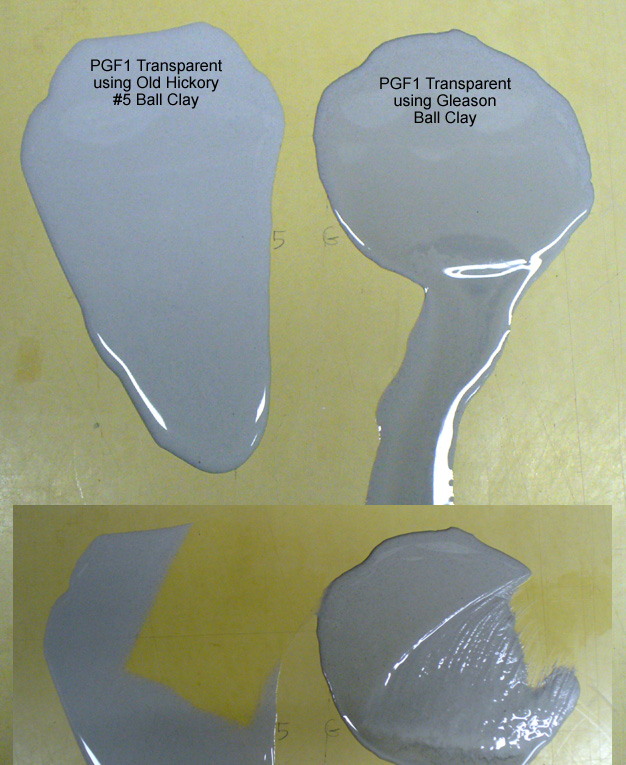| Monthly Tech-Tip | No tracking! No ads! | |
The ball clay you use to suspend your glaze is important!
I poured 4 teaspoons of two glazes onto a non-absorbent butcher’s board and let them sit for a minute, then inclined the board. The one on the right employs Gleason Ball clay, the left one has Old Hickory #5 ball clay. Neither has any rheology modifier additions. The one on the right has settled and, on incline of the board, the watery upper is running off. The other has gelled and the whole thing is running downward slowly. Below that you can see where I have begun to sponge them off, the one on the right is sticky. The most amazing thing about this: This difference appears despite the fact that there is only 7% ball clay in this heavily fritted recipe.
Related Pictures
What makes EP Kaolin unique? Are others as good?

This picture has its own page with more detail, click here to see it.
In ceramics, EPK, or EP Kaolin, is used in clay bodies and glazes. Top right: Pure EPK is fairly plastic on wedging. But during the throwing process, it splits at the rim like this. The forming properties that it does have thus seem to be as much related to its stickiness and cohesion as plasticity. Without the help of bentonite or ball clay this would not be able to host the addition of feldspar and silica to make a usable porcelain or stoneware. But EPK shines in what it does as a slurry. Left: This slurry has been mixed to only 1.15 specific gravity and forms a thixotropic gel that clings to the spatula in an even layer. Bottom: This low specific gravity gel is thick enough that it will hold this heavy spatula vertical! Considering that our typical glazes have a specific gravity of 1.45 yet are still quite fluid it is evident just how much EPK can gel (and suspend a suspension). It is thus no surprise that it is the kaolin of choice in ceramic glazes. Are there other sticky kaolins that gel like this? Yes. Grolleg and New Zealand kaolin.
Videos
Links
| Glossary |
Suspension
In ceramics, glazes are slurries. They consist of water and undissolved powders kept in suspension by clay particles. You have much more control over the properties than you might think. |
| Materials |
No. 5 Ball Clay
|
| Materials |
No. 1 Glaze Ball Clay
|
| Materials |
Ball Clay
A fine particled highly plastic secondary clay used mainly to impart plasticity to clay and porcelain bodies and to suspend glaze, slips and engobe slurries. |
| Troubles |
Glaze Slurry is Difficult to Use or Settling
Understanding glaze slurry rheology is the key to solving problems and creating a suspension that does not settle out, applies well, dries crack free. |
Got a Question?
Buy me a coffee and we can talk

https://digitalfire.com, All Rights Reserved
Privacy Policy

